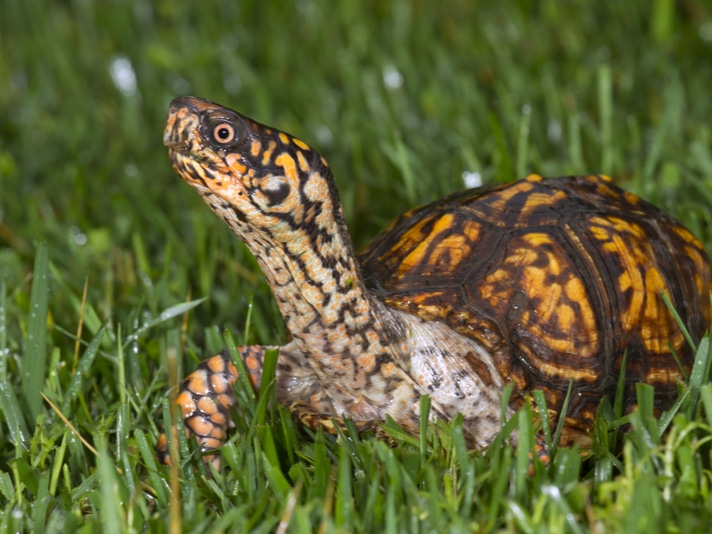Smart and fun to watch, box turtles make fantastic pets.
(Terrapene carolina carolina)
Size: Adults measure up to 61⁄2 inches long.
Life Span: Records of up to 70 years but possibly longer.
Range: Massachusetts to Illinois and south to Georgia.
Natural Habitat: Often found near water, box turtles’ habitats range from wooded areas, low-lying swampy areas, fields and forest margins.
Captive Housing: If kept indoors, a juvenile turtle can live in a plastic or glass enclosure measuring 2 feet long, 2 feet wide and 1 foot tall. Adults should be kept in a minimum 4 feet long, 2 feet wide and 2 foot tall.
Substrate can consist of potting soil without chemicals, cypress bark or crushed coconut fiber. Make the bedding deep enough to cover the entire turtle if it decides it wants to burrow. About 3 to 4 inches is adequate for an adult.
A shallow water bowl large enough for the turtle to soak is recommended. Water should only reach to the bottom of the turtle’s shell when it’s standing. Also keep an area of the enclosure moist by adding water as needed. This will help increase the humidity, which for an eastern box turtle needs to be between 60 to 70 percent.
Heating and lighting your turtle is fairly easy. Start with an ambient temperature of 75 degrees Fahrenheit, and add a ceramic heat emitter to create a basking area of 85 to 90 degrees. Place a hide, such as a wooden box or a commercial hide, at the cool and warm ends of the enclosure. Hides should be large enough to fit all cagemates together, and each turtle should be able to turn around or back out with ease. Add a fluorescent UVB bulb to run the total length of the enclosure. A 12-hour daylight cycle is recommended.
For box turtles kept outdoors, the minimum size for one turtle is 4 feet long, 4 feet wide and 2 foot tall. An enclosure measuring 8 feet long, 4 feet wide and 2 feet tall is great for a group of six to eight adults. Walls can be made of wood, plastic or metal. Make sure they extend about a foot deep into the ground to deter burrowing escapes.
Tilling soil to a loose consistency gives turtles plenty of places to burrow for security. Provide a number of hiding areas, so each turtle may have one. Live plants will also be used as secure areas.
A shallow water bowl big enough for several turtles to soak at once is a must. A sprinkler or misting system can be used to provide moisture and humidity. Box turtles can remain outside all year long. They bury themselves into about 4 to 6 inches of loose earth when the weather turns cold. Once turtles are down for the winter, spread straw or leaf litter over them. It provides insulation until they reappear in the spring.
Diet: Box turtles eat a variety of vegetables, fruit, commercial diets and a wide range of meat. Good choices are crickets, earthworms, mealworms and canned dog food, such as ground turkey, beaver and duck. Dust all food items, including insects, fruit and produce, with a calcium and multivitamin supplement. Box turtles love to chase crickets, and it is fun to watch, too. Provide a variety of food, and remove uneaten offerings each day. By observing how much and what your turtles eat, you can determine how much of which food to provide each day.
Some box turtles “dance” before a meal. Once they clear an area of leaf litter, they stomp about on the ground in an attempt to imitate the sound of rainfall. This causes worms, such as night crawlers, to emerge onto the surface and provide the box turtle with a nice snack.
What’s Available: Box turtles are protected within most of their range, and wild-caught adults are increasingly hard to locate. I recommend captive-bred box turtles, and they are becoming more common every year.
Several subspecies and many races of box turtles are on the market. All can be kept like eastern box turtles are, but some require different humidity and temperature levels. Don’t forget to always do your research before taking a pet home. Smart and fun to watch, box turtles make fantastic pets. They become outgoing and tame once established, and they give families many years of companionship and enjoyment.
Ken Foose produced his first captive-bred snakes at age 11. With a master’s in zoology, he has been both zookeeper and curator. He opened Exotic Pets, which specializes in reptiles and amphibians, in Las Vegas, Nev., 16 years ago, and he is currently vice president of the International Herpetological Symposium.



